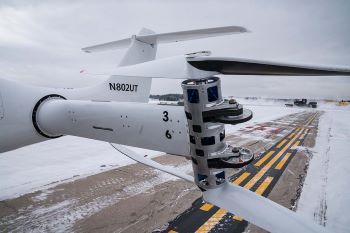This blog on eVTOL Sensor Integration is a variation on a blog originally titled “Beta Technologies’ EVTOL development takes off with Microstrain Sensors” was written by MicroStrain by HBK’s Sensing Field Application Engineer, Jody Dunklee.
Revolutionising EVTOL Development with Microstrain Sensors
Taking a closer look at how Beta Technologies is leveraging MicroStrain by HBK sensors in their EVTOL innovations.
Introduction: A Leap into the Future of Flight
Vertical Takeoff and Landing (VTOL) aircrafts are not new to the world of aviation. However, the birth of all-electric VTOLs (eVTOLs) capable of carrying passengers brings forth a revolution. A key player in this space is Beta Technologies, an innovative start up from Burlington, Vermont, championing the development of eVTOL technology. One of their projects involves designing an eVTOL that could potentially save lives by delivering human organs for transplant operations.
However, designing such an aircraft demands precision. And this is where Microstrain by HBK’s sensors come into play.
https://www.youtube.com/watch?v=HseXZY0gETs
Understanding the Prototype
Beta Technologies’ prototype eVTOL is nothing short of remarkable:
- Weight and Capacity: Can lift an impressive 1,814 kgs.
- Distance: Travel up to 240 kms on a single charge.
- Design: Comes with a 10.66 Metre wingspan and eight 75kW motors for optimal take-off and landing.
- Transition to Flight: Post take-off, the aircraft shifts from a vertical to a traditional flying mode.
- Speed and Elevation: Achieved a peak speed of 72 knots and an elevation of 30.48 Metres in over 180 FAA-approved test flights.
- Powered: 2 x 124 kWh Lithium Ion Battery packs powered all this motion.
Microstrain’s Role in Perfecting the Prototype
Several challenges arise when monitoring the data of such a complex prototype. But MicroStrain’s sensors were up to the task:
- Flight Control: To accurately control flight characteristics, three 3DM-GX5-25 inertial sensors were used. They monitored pitch, roll, and angular rate values, providing essential data to the flight computer.
- Test Stand Monitoring: Sensors here measured propeller thrust, vibration, strain, and load. This aided in understanding the propeller’s behaviour at different speeds and designs.
- Static Load Testing: Strain gauges attached to the airframe structure assisted in testing the static load.
- Temperature Monitoring: Given the potential risks with lithium-ion batteries, monitoring their temperature was paramount. Beta employed temperature probes and the MicroStrain TC-Link-200 nodes to transmit this data in real-time.
- Hover Motor Vibration Testing: G-Link-200 wireless accelerometers were essential in identifying aerodynamically induced vibrations and resonant frequencies.
Outcome
The integration of Microstrain by HBK’s sensors into Beta’s design and testing process was instrumental. Despite challenges such as high-power RF devices in close proximity and hard-to-monitor locations, the sensors provided invaluable feedback. This feedback is the key to Beta’s continuous prototype improvements, ensuring safer and more efficient future flights.
Explore Related Products
Looking to dive deeper into the tech behind this revolutionary development? Here are the key MicroStrain products involved:
The 3DM-GX5 is a powerful GNSS/INS tool. Firstly, it provides detailed position, velocity, and attitude outputs through an integrated combination of GNSS/GPS, magnetometers, gyroscopes, and accelerometers.
What sets the GX5 Series apart? Its versatility – it’s available across multiple product classes. Whether you’re looking at IMUs (Inertial Measurement Units) that focus on pitch, tilt, roll, and inclination outputs. Or delving into the more sophisticated AR (Attitude Reference), AHRS (Attitude and Heading Reference System), or INS (Inertial Navigation System) sensors. The GX5 series has got you covered. Welcome to a new era of precision.
Finally, Beta Technologies’ journey with eVTOLs, paired with Microstrain by HBK’s advanced sensors, paints an exciting picture for the future of aviation. Therefore, as we continue to push the abilities of what’s possible, working together like this paves the way for more up and coming solutions.
To learn more, contact us.
